DAVAO CITY (MindaNews / 03 February) – Mindanao’s ‘Ground Zero’ for African Swine Fever (ASF) is at the southernmost part of the Philippines, in the remote coastal town of Don Marcelino in Davao Occidental, a three-and-a-half-hour ride by car from Davao City, and authorities are still determining how the highly contagious hemorrhagic virus got there and killed, according to the mayor, “more or less 1,000” pigs in eight of the town’s 15 barangays as of January 31.
On Sunday, the town was placed under a state of calamity and residents urged to report to their barangay officials an inventory of their swine population — how many are alive, sick and dead.
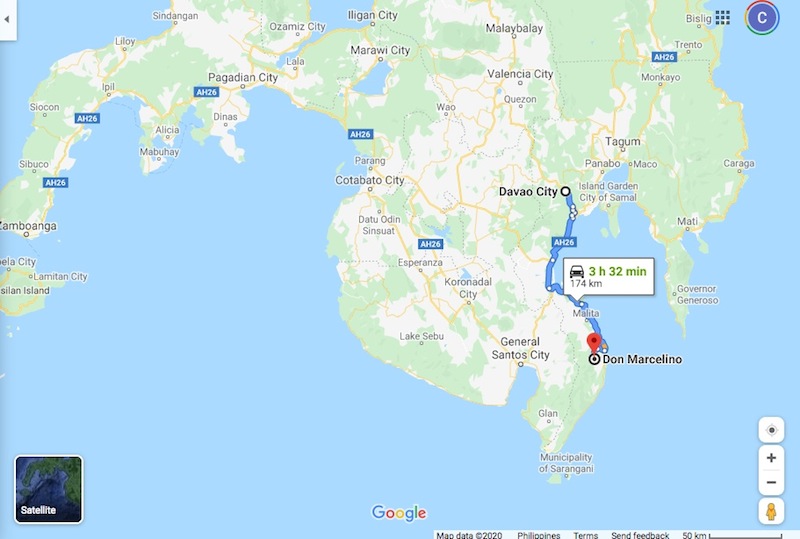 Don Marcelino town in Davao Occidental, ‘Ground Zero’ for African Swine Fever in Mindanao is 3.5 hours away from Davao City. Map courtesy of Google
Don Marcelino town in Davao Occidental, ‘Ground Zero’ for African Swine Fever in Mindanao is 3.5 hours away from Davao City. Map courtesy of Google
“We don’t know kung saan galing yung virus (where the virus came from). We are still ascertaining that,” Agriculture Secretary William Dar told the Philippine Information Agency (PIA) in Don Marcelino on Sunday.
Dar said the national government will pay residents 5,000 pesos for every infected pig while the provincial government will pay for those not yet affected at half its value. The town has an estimated 13,000 swine population.
This is the first recorded outbreak among Mindanao’s six regions, prompting the Regional Disaster Risk Reduction and Management Council (RDRRMC) on January 31 to activate the Regional Animal Disease Task Force.
On September 9, Dar confirmed the ASF had reached the country, specifically in two Luzon provinces, its origins later traced to smuggled pork products from China.
The initial reported death of “more or less 1,000” in Don Marcelino is more than the number of deaths listed in seven reports submitted by the DA’s Bureau of Animal Industry (BAI) to the OiE World Organization for Health between September 9 and January 29: a total of 761 deaths from 170 outbreaks in Luzon since the entry of ASF in the country. Based on these reports, a total of 191,641 hogs were culled to prevent the spread of the disease.
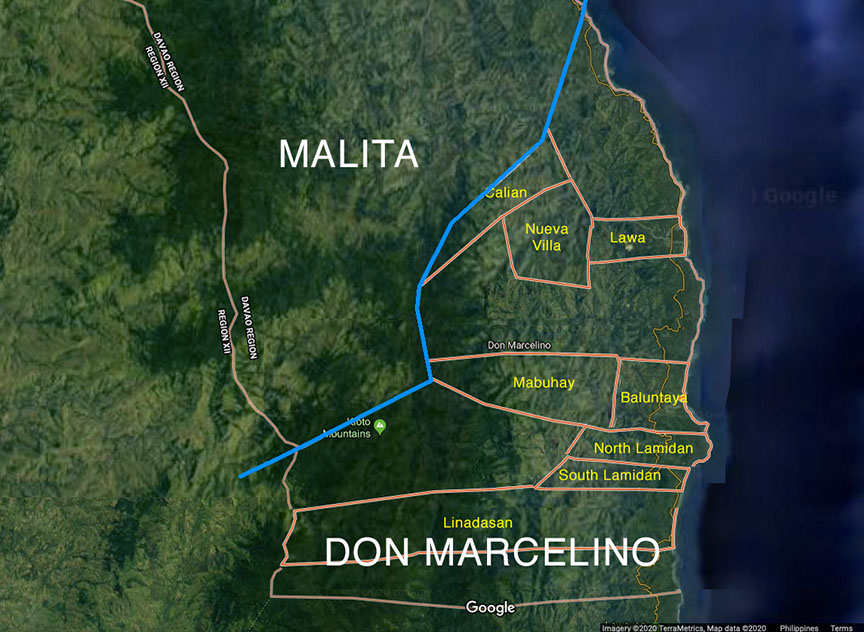 Map shows eight of Don Marcelino’s 15 barangays where “more or less” 1,000 pigs have died due to the African Swine Fever.MINDANEWS. map courtesy of Google
Map shows eight of Don Marcelino’s 15 barangays where “more or less” 1,000 pigs have died due to the African Swine Fever.MINDANEWS. map courtesy of Google
In his memorandum to the police chief and all barangay chairs on January 31, Don Marcelino mayor Michael Maruya said “more or less 1,000” pigs have died in eight of its 15 barangays — Baluntaya, Calian, Lawa, Linadasan, Mabuhay, Nueva Villa, North Lamidan and South Lamidan – and the DA and Provincial Veterinarian Office after conducting sample collection and validation, “recommended temporary lockdown” to limit the movement of pork and other pork products.
Dar said an estimated 13,000 hogs may have been affected
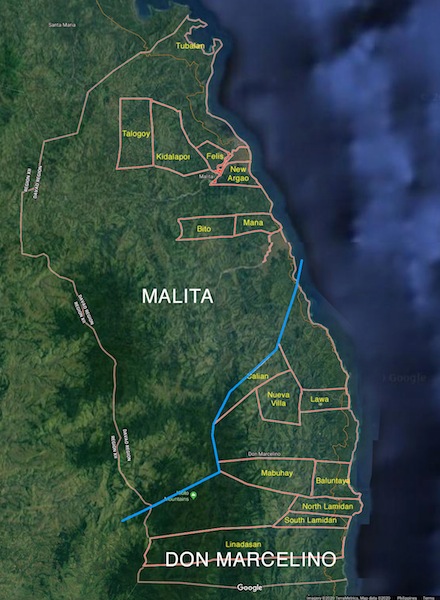 Map shows eight barangays in Don Marcelino, the “Ground Zero’ for the African Swine Fever in Mindanao. The Department of Agriculture in a press release on February 2, said the quick reaction team that checked on these villages also “reported ASF incidence in seven barangays in adjacent town of Malita, the capital of Davao Occidental. As the map shows, not all the affected barangays are contiguous. MINDANEWS / map courtesy of google
Map shows eight barangays in Don Marcelino, the “Ground Zero’ for the African Swine Fever in Mindanao. The Department of Agriculture in a press release on February 2, said the quick reaction team that checked on these villages also “reported ASF incidence in seven barangays in adjacent town of Malita, the capital of Davao Occidental. As the map shows, not all the affected barangays are contiguous. MINDANEWS / map courtesy of google
The mayor ordered the setting up of checkpoints 24/7 to prevent the disease from spreading but it may have spread already as the DA in a press release on February 2 said the Quick Response Team, along with the municipal and provincial veterinarians that conducted an investigation in the eight barangays of Don Marcelino on January 29, “also reported ASF incidence in seven barangays in Bito, Kidalapong, Felis, Mana, New Argao, Talogoy and Taubalan in neighboring Malita town. Malita has 30 barangays.
The BAI as of February 2, had yet to report to the world body on the ASF in Mindanao.
Highly contagious; dead within 2 to 10 days
ASF, it said, is a highly contagious hemorrhagic viral disease affecting domestic and wild pigs, and although it poses no risk to humans, causes serious economic and production losses.
The transboundary disease can be spread by live or dead pigs, domestic or wild, and pork products, it said.
The BAI said the disease is “characterized by high fever, loss of appetite, hemorrhages in the skin and internal organs, and death which follows between two to 10 days on the average” and mortality can be as high as 100%.
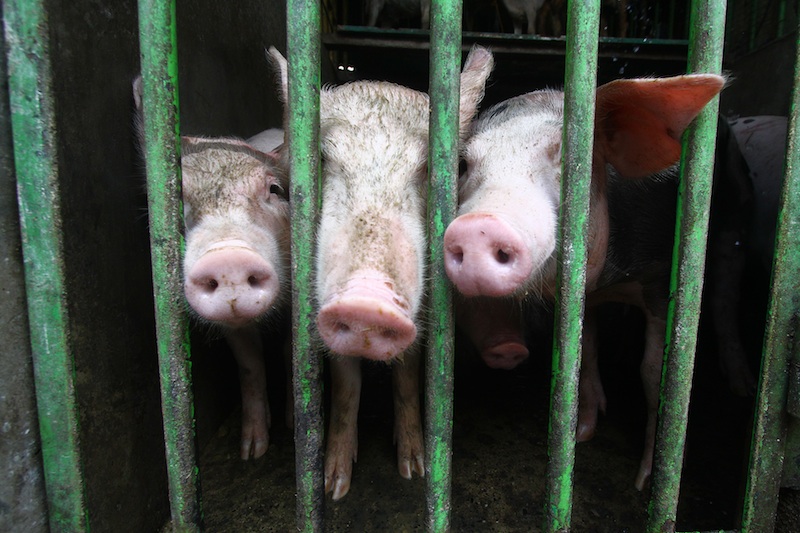 The Department of Agriculture has confirmed the presence of the African Swine Fever in Don Marcelino town in Davao Occidental, the first reported outbreak in Mindanao. MINDANEWS PHOTO
The Department of Agriculture has confirmed the presence of the African Swine Fever in Don Marcelino town in Davao Occidental, the first reported outbreak in Mindanao. MINDANEWS PHOTO
There is currently no vaccine against ASF and no treatment is available, it added.
The BAI said the disease is transmitted by direct contact or by ingestion of garbage/swill feeds containing infected pig meat or pig meat products, ticks and biting files, contaminated premises, vehicles, equipment and clothing.
ASF, it stressed, is “not a human health threat.”
‘Ground Zero’
In what barangay were the first deaths reported and when? Why did it take a thousand deaths before the ASF was confirmed and actions undertaken? MindaNews sent several queries to the regional task force’s ASF focal person, Dr. Armie Capuyan, but she has yet to respond.
Davao Occidental Governor Claude Bautista told the PIA on Sunday that there will be “thorough investigations” and that he would call on the municipal and provincial veterinarians and listen to the testimonies of residents who had complained to them before hand “kung bakit hindi kaagad na-address itong problema, bakit umabot pa sa ganito” (why this problem was not immediately addressed, why it has come to this).
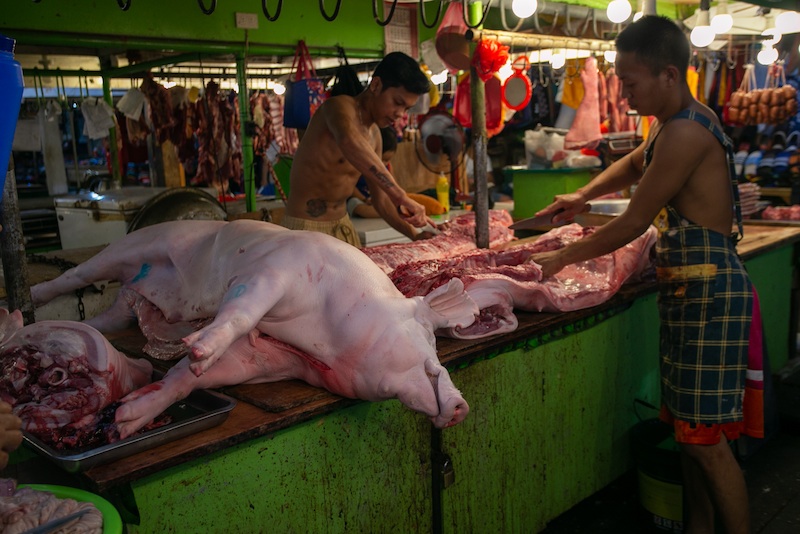 Meat vendors prepare pork cuts at the Agdao Public Market in Davao City on 3 February 2020. Davao City Mayor Sara Duterte has ordered a ban on the entry of pigs and pig products from Davao Occidental and Davao del Sur following the presence of African Swine Fever in Don Marcelino, Davao Occidental. MindaNews photo by MANMAN DEJETO
Meat vendors prepare pork cuts at the Agdao Public Market in Davao City on 3 February 2020. Davao City Mayor Sara Duterte has ordered a ban on the entry of pigs and pig products from Davao Occidental and Davao del Sur following the presence of African Swine Fever in Don Marcelino, Davao Occidental. MindaNews photo by MANMAN DEJETO
Former Agriculture Secretary Emmanuel Pinol, now chair of the Mindanao Development Authority said “how and why the ASF got to the remote town could not yet be answered” but these “could be addressed later.”
“This is also not the time to play the blame game,” Pinol wrote on his Facebook page on Saturday, adding what needs to be done is to “contain the spread of the disease by immediately implementing quarantine measures.”
Pinol went to Don Marcelino on Sunday to offer his help.
In a statement, House Deputy Minority Leader and Bayan Muna Rep. Carlos Isagani Zarate said the “economic time bomb” he warned about in October during a House probe on the ASF, “is now becoming true due to the ‘under control’ attitude of our officials.”
“This ticking economic devastating time-bomb is about to explode, yet, it appears the agriculture officials and even some industry players would rather downplay the catastrophic effects of this problem,” he said.
Davao City Mayor Sara Duterte on Monday ordered a total ban, although temporary, on live pigs and pork products from Davao Occidental and neighboring Davao del Sur where a suspected ASF case has been monitored.
From Rizal, Bulacan
Dar confirmed the presence of ASF in the country on September 9, specifically in the provinces of Rizal and Bulacan. Since then, outbreaks had also been reported in Pampanga, Caloocan, Nueva Ecija and Cavite.
On November 4 last year, Dar told a press briefing that ASF presence in the country originated from meat smuggled into the country from China.
On January 25, the Bureau of Customs reported that a shipment of pork-celery dumplings from China which was seized at a port in Manila last December, tested positive for ASF.
This, even as the Philippines had earlier banned import of pork and pork products from 16 countries hit by swine fever, including China.
Activated
Liza Mazo, regional director of the Office of Civil Defense (OCD) and chair of the RDRRMC activated the task force in a memorandum on January 31.
The task force is headed by the DA regional director and co-chaired by the Bureau of Animal Industry-Veterinary Quarantine Chief and OCD. It has four teams: Rapid Action, Surveillance, Quarantine, and Communication, Education, Participation and Awareness.
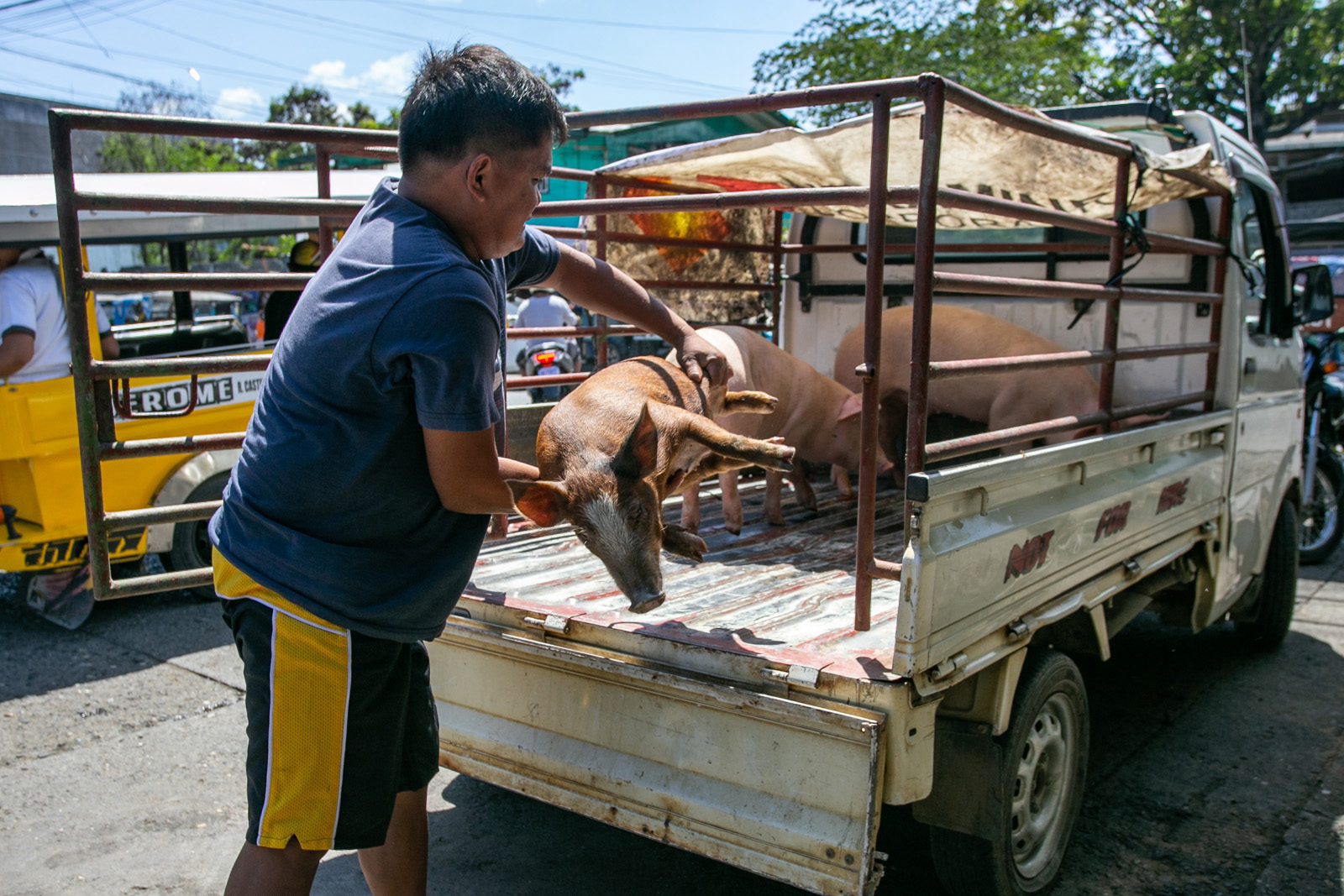 A livestock dealer loads pigs on a delivery truck at the Agdao Public Market in Davao City on 3 February 2020. Davao City Mayor Sara Duterte has ordered a ban on the entry of pigs and pork products from Davao Occidental and Davao del Sur following the outbreak of African Swine Fever in Don Marcelino, Davao Occidental. MindaNews photo by MANMAN DEJETO
A livestock dealer loads pigs on a delivery truck at the Agdao Public Market in Davao City on 3 February 2020. Davao City Mayor Sara Duterte has ordered a ban on the entry of pigs and pork products from Davao Occidental and Davao del Sur following the outbreak of African Swine Fever in Don Marcelino, Davao Occidental. MindaNews photo by MANMAN DEJETO
According to its protocol, the Rapid Action Team’s mandate is to stamp out the animal population within the facility/establishment where index case was identified and stamping out is to be conducted “immediately after the declaration of the DA Secretary of a disease positive case.”
If positive, “all animals in the infected zone shall be humanely depopulated,” the task force said.
Proper disposal/burial of carcass, by-products such as feathers and manure and other materials are to be done in the identified site.
“If stamping out was conducted in the farm, burial shall be onsite.
If on barangay level or live bird markets, animal carcasses and other materials shall be loaded and transported f or incineration or burial in a designated area,” it said.
1-7-10
The rapid action team is also tasked to clean and disinfect infected premises, conveyances, and materials that came into contact with animals that were infected or exposed to the causative agent.
The Surveillance Team is tasked to conduct risk-based surveillance along the market chain, to define the geographic area supplying market traders and sampling undertaken in markets and farms that supply the identified positive area.
The Quarantine Team is tasked to prohibit the trading of live poultry or livestock and “other activities involving live within 100 meters around the vicinity of infected poultry facility/establishment.”
The team is mandated to man checkpoints, seize, confiscate and properly dispose of undocumented live livestock, poultry and related product shipments.
According to the DA’s ASF Contingency Plan, the 1-7-10 kilometer zone must be observed.
Infected Zone is set at 1 km radius from the suspect premise – an area or farm where the pigs are confirmed to be infected with ASF — intended to contain infection by limiting movement and employing mandatory test and slaughter strategy in all pigs; Quarantine Zone is set at 7 km radius intended to contain infection by limiting movement; and Control Zone is set at 10 km radius intended to detect infection at an early stage. (Carolyn O. Arguillas / MindaNews)
